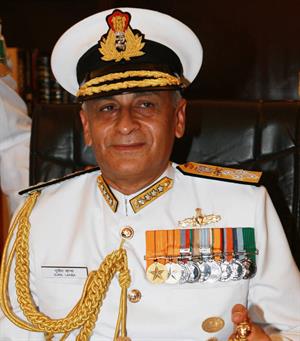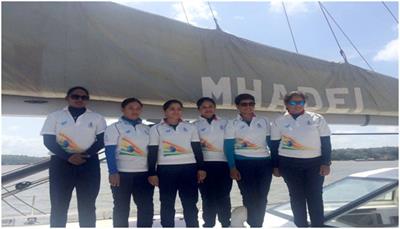PDF chapter test TRY NOW
Navika Sagar Parikrama was a project undertaken in consonance with the National policy to empower women to attain their full potential. “The Project is considered essential towards promoting ocean sailing activities in the Navy while depicting Government of India’s thrust for Nari Shakti (women power),” said Chief of the Naval Staff, Admiral Sunil Lanba in his welcome speech.
The voyage was aimed to show case ‘Make in India’ initiative by sailing onboard indigenously built INSV Tarini. The special feature of this sailboat is that it encouraged use of environment friendly non-conventional renewable energy resources such as the wind; collected and updated meteorological, ocean and wave data on regular basis for accurate weather forecast by India Meteorological Department (IMD) and also collected data for monitoring marine pollution on
high seas.
Indian Navy’s Six Women Crew
Indian Navy’s all-women crew was the first-ever to circumnavigate the globe skippered by Lt. Commander Vartika Joshi. The all-women team has also Lt. Cdr. Pratibh Jamwal, Lt. Cdr. Swathi Patarapalli, Lt. Aishwarya Boddapati, Lt. Sh. Vijaya Devi and Lt. Payal Gupta as its crew members.
The crew started their voyage on 10 September 2017 from Goa, flagged off by the Defence Minister of India. It was a historic day, which would be marked in navigation history and globally. It covered the expedition in five legs with stopovers at four ports (Fremantle, Australia; Lyttleton, New Zealand; Port Stanley, the Falklands and Cape Town, South Africa) for replenishment of ration and repair as necessary, before returning to Goa in April 2018. They went around the globe within 254-days and reached Goa port on 21 May 2018. The six member women crew broke many stereotypes during their record-setting sail.
Explanation:
In India, a project was launched to promote the Women's Navy Force. The project was called Navika Sagar Parikrama. The major theme of the project was carried out in agreement with national policy. Its goal was to inspire women to attain their greatest potential. Admiral Sunil Lanba, the Chief of Naval Staff, delivered a forceful message in his welcome speech. He claimed that the project's goal was to "promote ocean sailing activities in the Navy while also demonstrating the Government of India's ambition for Nari Shakti (women power)."

Admiral Sunil Lanba*
The foremost goal of the expedition was to showcase the 'Make in India' effort by travelling onboard the INSV Tarini, which was built entirely in India. This sailboat was notable for encouraging the use of environmentally friendly non-conventional renewable energy sources such as wind; collecting and updating meteorological, ocean, and wave data regularly for accurate weather forecasting by the India Meteorological Department (IMD); and collecting data for monitoring marine pollution on the high seas.
The Indian Navy had a crew of six people. The Indian Navy's all-women crew was the first to circumnavigate the globe, and Lt. Commander Vartika Joshi led the team. The team also had other five women crew embers. They were Lt. Cdr. Pratibh Jamwal, Lt. Cdr. Swathi Patarapalli, Lt. Aishwarya Boddapati, Lt. Sh. Vijaya Devi and Lt. Payal Gupta.

The Indian Navy's all-women crew set sail from Goa on September 10, 2017. It was carried out with the approval of India's Defence Minister. It was a momentous occasion in navigational history that would be recognised around the world. The journey was divided into five stages. This sailboat stops at four different ports.
The ports where the sailboat stops were Fremantle (Australia), Lyttleton (New Zealand), Port Stanley (Falkland Islands) and Cape Town (South Africa). The primary purpose of stopping the sailboat in these places was to refill the food requirements and check the boat's maintenance whenever needed. The crew hoped that they would return to Goa in April 2018. But the all Indian woman travelled around the world in 254 days and arrived in Goa port on May 21, 2018. During their world-record-breaking sail, the six-member of the women crew broke out many stereotypes.
Meanings of the difficult words:
S.No | Words | Meanings |
1 | Consonance | Agreement or compatibility between opinions or actions |
2 | Empower | To give someone official authority or the freedom to do something |
3 | Voyage | A long journey, especially by ship |
4 | Accurate | Correct, exact, and without any mistakes |
5 | Forecast | To say what you expect to happen in the future |
6 | Expedition | An organised journey for a particular purpose |
7 | Stopover | A short stay in a place that you make while you are on a longer journey to somewhere else |
8 | Replenishment | The act of filling something up again by replacing what has been used |
Reference:
State Council of Educational Research and Training (2018). Term-1 English Standard-10. Empowered Women Navigating the World (pp. 60-83). Published by the Tamil Nadu Textbook and Educational Services Corporation.
